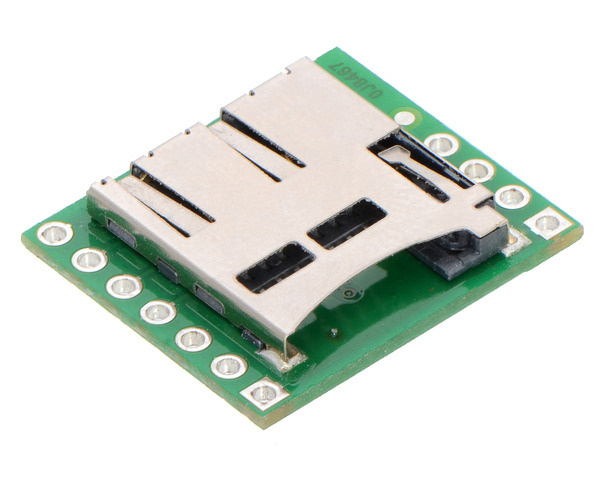

This is a merged information page for Item #2597.
View normal product page.
Pololu item #:
2597
Brand:
Pololu
Status:
Active and Preferred

This simple board breaks out the pins of a microSD card connector to a 0.1″ pin spacing that is compatible with standard perfboards, solderless breadboards, and 0.1" connectors.
 Compare all products in Electronics Prototyping.
Compare all products in Electronics Prototyping.
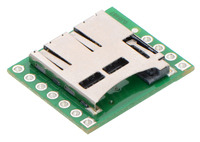 |
Breakout Board for microSD Card. |
|---|
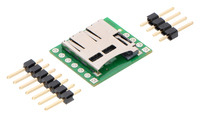 |
Breakout Board for microSD Card with included header pins. |
|---|
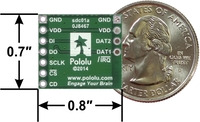 |
Breakout Board for microSD Card, bottom view with dimensions. |
|---|
 |
Breakout Board for microSD Card, labeled top view. |
|---|
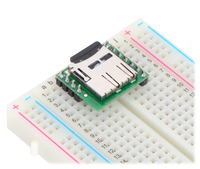 |
Breakout Board for microSD Card plugged into a breadboard with microSD card (not included) inserted. |
|---|
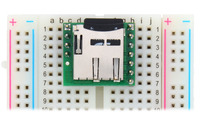 |
Breakout Board for microSD Card plugged into a breadboard with microSD card (not included) inserted. |
|---|
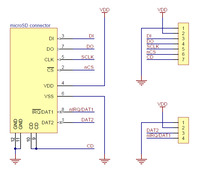 |
Breakout Board for microSD Card schematic diagram. |
|---|
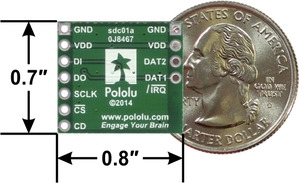 |
MicroSD memory cards (originally known as TransFlash) provide a compact and inexpensive way to add gigabytes of non-volatile storage to a project. All SD cards support communication over the SPI (Serial Peripheral Interface) bus, making it straightforward to interface one of these cards with an SPI-capable microcontroller.
This carrier board makes it easy to connect to a microSD card by breaking out all of the contacts from a microSD card socket into two rows of 0.1″-spaced pins. The board measures only 0.8″ × 0.7″, and a set of breakaway 0.1″ male header strips (one 1×7 and one 1×4) is included, which can be soldered in to use the board with breadboards, perfboards, or 0.1″ female connectors. (The headers might ship as a single 1×11 piece that can be broken in two).
|
|
We also carry a larger microSD card breakout board with a 3.3V regulator and level shifters that can be directly integrated into 5 V systems; it only breaks breaks out the more commonly used SPI bus mode interface pins, and it includes two mounting holes. The pictures below show the two versions side-by-side.
|
|
Since many microcontrollers have built-in SPI interfaces, most hobbyist projects communicate with Secure Digital cards in SPI bus mode. (The alternative SD bus mode is proprietary, and a license from the SD Association is required for access to the full specifications.) Where applicable, the pins on this board are labeled according to their functions in SPI mode.
All of the microSD card’s power pins and all of the signal pins necessary to interface with the card through SPI are available along the right side of the board. The left side of the board exposes duplicate power pins, along with two additional signal lines (DAT1 and DAT2) that are not needed for SPI communication but are used in 4-bit SD bus mode. The DAT1 pin also serves as an interrupt pin (IRQ) in SDIO devices. (Note that if you are using this module in a breadboard, you might want to solder header pins into both sides of the board for added stability even if you only plan to use the SPI pins.)
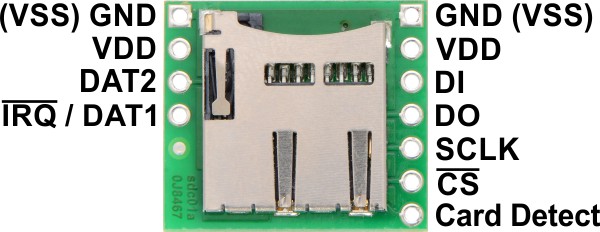 |
The following tables describe the function of each pin on the breakout board in SPI and SD mode:
| Pin | Description | ||
|---|---|---|---|
| GND (VSS) |
Power and logic ground | ||
| VDD | Supply voltage (2.7 V to 3.6 V for standard microSD cards) | ||
| CD | Card detect. When a card is inserted, this pin is floating; when no card is inserted, it is shorted to ground. A pull-up resistor can be used to pull the line high when a card is present. | ||
| SPI mode | SD mode | ||
| Pin | Description | Pin | Description |
| DI | Data in (MOSI) | CMD | Command/response |
| DO | Data out (MISO) | DAT0 | Data (bit 0) |
| SCLK | Clock | CLK | Clock |
| CS | Chip select (active low) | DAT3 | Data (bit 3) |
| — IRQ |
Reserved Interrupt (active low; SDIO devices only) |
DAT1 IRQ |
Data (bit 1) Interrupt (active low; SDIO devices only) |
| — | Reserved | DAT2 | Data (bit 2) |
Warning: Standard microSD cards use 3.3 V logic level signals, so level shifters or voltage dividers are required when connecting one to a 5 V system.
The SD Association publishes a set of simplified specifications for SD cards containing information on interfacing with them. However, there are a number of ways to get started without understanding the specifications or writing your own code from scratch, since many microcontroller development platforms provide libraries for communicating with SD cards. For example:
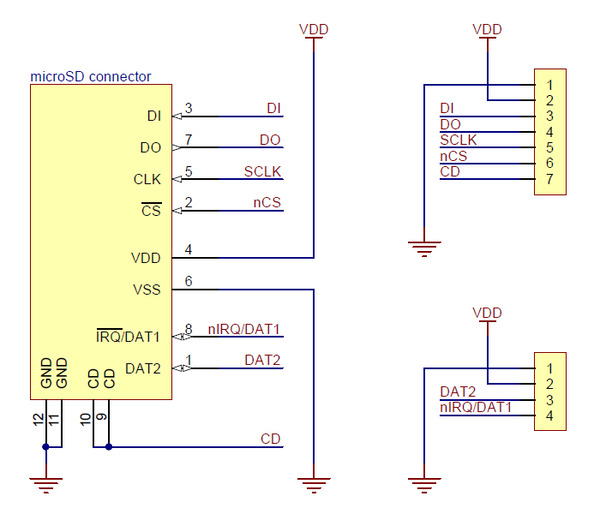 |
Breakout Board for microSD Card schematic diagram. |
|---|
This schematic is also available as a downloadable pdf (140k pdf).
| Size: | 0.8″ × 0.7″ × 0.12″1 |
|---|---|
| Weight: | 1.3 g2 |
| PCB dev codes: | sdc01a |
|---|---|
| Other PCB markings: | 0J8467 |
Printable schematic for the Breakout Board for microSD Card.
This DXF drawing shows the locations of all of the board’s holes.
The SD Association’s simplified standard specifications for SD cards.
No FAQs available.
Pololu customer Yvon Hache made this 3D-printed aerial photography rig that he shared in a forum post. The rig, trailing 100 feet below the kite,...
In September of last year, we started carrying our Breakout Board for microSD Card, which was the first board that I ever designed and routed here...
Last week, Jon mentioned how several of the mechanical engineers here at Pololu were assigned a simple board to develop. Well, our new Breakout...